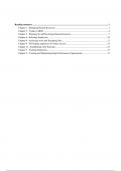Samenvatting
Extensive summary of all required readings for Human Resource Management
- Instelling
- Universiteit Van Amsterdam (UvA)
Providing an in-depth and complete summary of all required readings for the HRM class of the Business Administration department at UvA. Book chapters are summarised in detail
[Meer zien]





